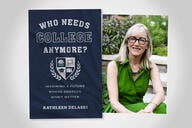You have /5 articles left.
Sign up for a free account or log in.

Simone de Beauvoir
Wikipedia
Theories abound as to why women are underrepresented among philosophy scholars. Most philosophers are male, and that’s off-putting to those who would study them, some say. Others claim corners of the discipline are misogynistic. But the data as to why women make up just 21 percent of philosophy faculty – unusually low among the humanities – are scant. And women aren't flocking the field as undergraduate majors, either, even though many take a course or two. So one university is stacking some course syllabuses with female thinkers to see whether it’s a way to retain women’s interest in philosophy. And while many within the discipline are applauding Georgia State University, others question the academic value of such a move.
Starting next year, graduate students teaching introductory-level courses in philosophy at Georgia State, who teach about half of all such sections offered, will use syllabuses that include at least 20 percent women philosophers. That's at least double the number included on most syllabuses for the course at the university. The effort is an extension of preliminary research by Eddy Nahmias, professor of philosophy, and several of his graduate students, Toni Adleberg and Morgan Thompson, into why male and female students enroll in introductory-level courses in similar numbers but women drop out of the discipline in much greater numbers.
Through a large-scale climate survey, Nahmias and his students found marked differences in experiences among 700 male and female Introduction to Philosophy students. Women generally found the course less enjoyable, and the material less interesting and relevant to their lives, than their male counterparts. They also felt they had less in common with philosophy majors or instructors and felt less able and likely to succeed in philosophy. They reported being less likely to enroll in more advanced philosophy courses or major in the discipline, and were likelier to disagree that the syllabus included a fair proportion of women authors. (Women were no more likely to report that class conversations were aggressive, or to anticipate lower grades, however.)
Nahmias said he’ll run the survey again this fall, this time with more questions, and include a survey for instructors. Whether the female students enrolled in the courses with more readings by women report better experiences, and plan to enroll in more philosophy courses, could provide some insight into why most women abandon philosophy after introductory courses.
However, he said, “we are not sure if this experiment will succeed, we are not sure if it has any drawbacks, and, most importantly, we are not suggesting it is the only, or even the best, approach to mitigating the problem that motivated us” – that only about one-third of philosophy majors nationwide, and at Georgia State, are women.
The initiative is gaining praise from many in philosophy.
Amy Ferrer, executive director of the American Philosophical Association, said she and her organization are “very supportive of efforts like this one aiming to increase the representation of women in philosophy.” The documented drop in enrollment among women beyond introductory courses makes for “an unfortunate gender disparity in the philosophy major, philosophy graduate programs and the professoriate,” she said, adding that she was looking forward to seeing how much of an impact early undergraduate exposure to more female philosophers would have on the phenomenon.
Jennifer Saul, professor of philosophy at the University of Sheffield in Britain, who moderates the blog “What Is It Like to Be a Woman in Philosophy?” was equally enthusiastic.
Based on readers’ reports, Saul said “conscious sexism and sexual harassment seem to be alive and well in philosophy. Many women, with good reason, find philosophy to be an extremely hostile environment and it’s not surprising they leave it.”
But, perhaps more often, both women and men come to see philosophy as “male,” due to “overwhelmingly male instructors and male syllabi.” Saul said this can undermine women’s performance and make them want to leave the discipline, similar to what happens in the science, technology, engineering and math (STEM) fields -- although the dearth of women in STEM fields has been studied much more extensively, she said.
Moreover, Saul said, “20 percent is a pretty low number. It won’t be hard for syllabi to be rewritten to achieve this.”
But the idea of using quotas to craft syllabuses has its critics, too.
Molly Paxton, a philosophy graduate student at the University of Minnesota, co-authored a 2012 study that found women tend to leave the discipline following introductory-level courses, and that their rate of departure can be mitigated by increased numbers of female faculty members. She said she opposed the Georgia State model based on its assumption that the way to diversify philosophy is to start with students, from the “bottom up.”
“I think that it simply delays the inevitable exodus from philosophy that students will make when they realize that professional philosophy does not offer the same opportunities for those interested in certain areas of philosophy as it does for others,” she said. “The questions about how to make professional philosophy more diverse have to do with factors such as who can or can't publish, who is or isn't invited to speak at conferences, and who is and isn't hired.”
Lack of diversity among majors and faculty within the discipline is a reflection of the discipline itself, she said. “We need only look at the current minority of philosophers working in such areas as African-American philosophy, Asian philosophy, and even feminist philosophy to see that this type of diversity in philosophy does not have as much influence in top philosophical journals or conferences as work done in more 'traditional' areas, such as epistemology or metaphysics.”
Peter Wood, president of the National Association of Scholars, a group that advocates for a rigorous curriculum and opposes many affirmative action efforts, disagreed with the idea, calling it “on its surface, rather anti-intellectual.” Philosophy is normally taught historically and thematically, he said, and “it’s hard to imagine a grid which considers the gender of the author as relevant to either of those enterprises.” More attention should be paid to the “deep and important differences” of ideas within philosophical tradition than “superficial views of diversity” based on social groups such as class, gender and race, he said.
Kathryn Norlock, professor of philosophy at Trent University in Ontario, said she’d encountered similar criticisms in previous discussions about how greater exposure to female philosophers could attract more women to the field, and found them unconvincing. She supported the Georgia State initiative, she added.
“A common objection is that we shouldn’t be assigning authors based on their ‘identities,’ and should instead focus on teaching what’s ‘best,’ ” she said. “But what’s ‘best’ to the objectors often turns out to be teaching the canonical figures, but caring about who’s in the canon shows high attention to an author’s identity, too, and who’s in the canon is the result of social and political motivations and forces. And frankly, teaching the level-best text isn’t our only function, especially in introductory classes.”
Valerie Tiberius, a professor of philosophy at the University of Minnesota who co-authored the study with Paxton, said she favored a more complex explanation as to why women drop out of philosophy, including a mixture of overt and implicit sexism and norms of conversation that permit or even encourage aggression. (Louise Antony, professor of philosophy at the University of Massachusetts at Amherst, has argued that these factors come together in philosophy in particular to create a "perfect storm" that negatively impacts women's views of the discipline.) But Tiberius endorsed the 20 percent proposition. "It's certainly worth a try [and] having more women philosophers assigned in courses will also be good for the women who do stay in philosophy, not to mention for the men in philosophy"
Nahmias acknowledged that his experiment is only one way to examine the complicated problem of women leaving the discipline following introductory courses. But, he said, “Unless this drop-off is addressed, the underrepresentation of women in Ph.D. programs and as professors of philosophy, an issue which has gotten some attention recently, cannot be solved.”





